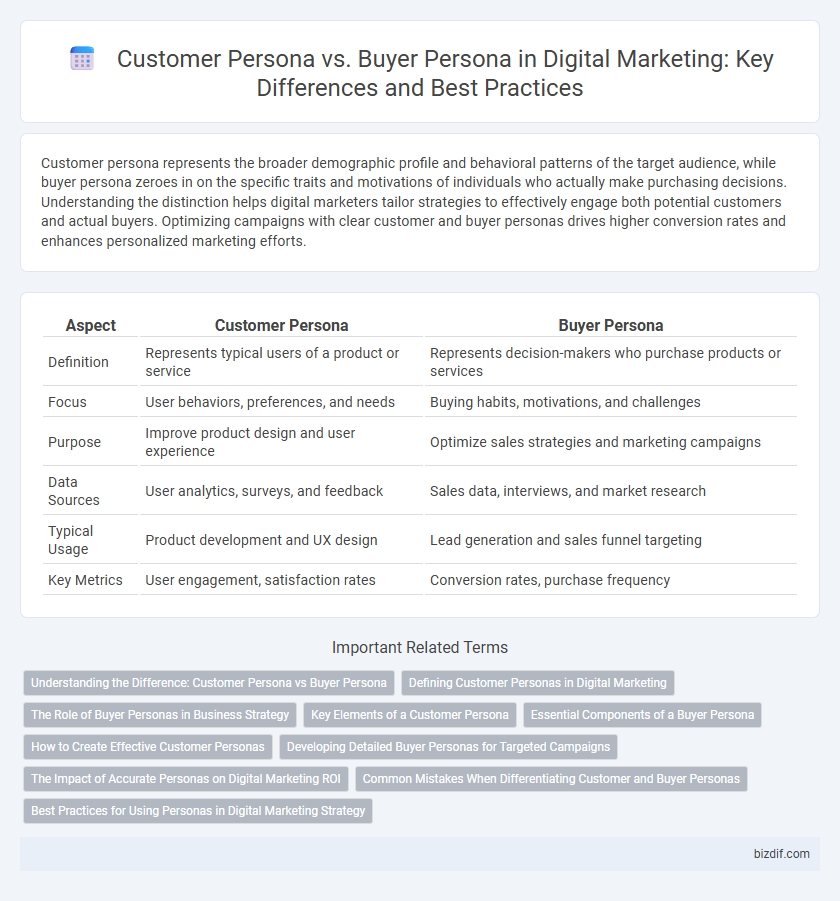Customer persona represents the broader demographic profile and behavioral patterns of the target audience, while buyer persona zeroes in on the specific traits and motivations of individuals who actually make purchasing decisions. Understanding the distinction helps digital marketers tailor strategies to effectively engage both potential customers and actual buyers. Optimizing campaigns with clear customer and buyer personas drives higher conversion rates and enhances personalized marketing efforts.
Table of Comparison
| Aspect | Customer Persona | Buyer Persona |
|---|---|---|
| Definition | Represents typical users of a product or service | Represents decision-makers who purchase products or services |
| Focus | User behaviors, preferences, and needs | Buying habits, motivations, and challenges |
| Purpose | Improve product design and user experience | Optimize sales strategies and marketing campaigns |
| Data Sources | User analytics, surveys, and feedback | Sales data, interviews, and market research |
| Typical Usage | Product development and UX design | Lead generation and sales funnel targeting |
| Key Metrics | User engagement, satisfaction rates | Conversion rates, purchase frequency |
Understanding the Difference: Customer Persona vs Buyer Persona
Customer persona represents the broader profile of an individual who engages with a brand or product, focusing on demographic, psychographic, and behavioral traits to enhance overall marketing strategies. Buyer persona zeroes in on the specific characteristics and motivations of individuals who make purchasing decisions, aiding sales teams in tailoring targeted sales approaches. Distinguishing between customer persona and buyer persona is crucial for creating precise marketing campaigns that address both engagement and conversion effectively.
Defining Customer Personas in Digital Marketing
Defining customer personas in digital marketing involves creating detailed profiles based on demographic data, online behavior, and purchasing patterns to represent a brand's ideal audience. These personas help marketers tailor content, advertising strategies, and user experiences to meet specific customer needs and preferences. Customer personas differ from buyer personas by encompassing broader user characteristics, including emotional drivers and engagement touchpoints beyond the purchasing decision.
The Role of Buyer Personas in Business Strategy
Buyer personas play a critical role in business strategy by providing detailed insights into customer motivations, purchasing behavior, and decision-making processes. Unlike general customer personas, buyer personas focus on the specific needs and challenges that drive purchasing actions, enabling precise targeting and personalized marketing campaigns. Integrating buyer personas into strategic planning enhances product development, sales alignment, and customer retention efforts, ultimately increasing ROI and competitive advantage.
Key Elements of a Customer Persona
A Customer Persona centers on key elements such as demographics, pain points, buying behavior, and motivation to purchase, providing a granular understanding of the target audience. It includes factors like age, gender, income, interests, challenges, and preferred communication channels, which help tailor marketing strategies effectively. This detailed profile enables brands to create personalized campaigns that resonate deeply with potential customers and drive engagement.
Essential Components of a Buyer Persona
A buyer persona in digital marketing is a detailed representation of the ideal customer, emphasizing demographic data, purchasing behavior, motivations, and pain points to tailor marketing strategies effectively. Essential components include age, job role, income level, buying preferences, challenges faced, and goals related to the product or service. Understanding these factors allows marketers to create targeted campaigns that resonate deeply and drive higher conversion rates.
How to Create Effective Customer Personas
Creating effective customer personas involves analyzing demographic data, purchasing behavior, and user goals to accurately represent target audiences. Distinguishing between customer personas, which focus on end-users, and buyer personas, centered on decision-makers, ensures tailored marketing strategies. Incorporating qualitative insights from surveys and interviews enhances persona relevance, improving campaign targeting and engagement.
Developing Detailed Buyer Personas for Targeted Campaigns
Developing detailed buyer personas involves analyzing demographic data, purchasing behaviors, and pain points to create accurate representations of ideal customers. Unlike broader customer personas, buyer personas focus specifically on decision-making processes and motivations behind purchasing actions. Targeted campaigns using precise buyer personas improve ad relevance, engagement rates, and conversion by addressing specific needs and preferences.
The Impact of Accurate Personas on Digital Marketing ROI
Accurate customer and buyer personas significantly enhance digital marketing ROI by enabling highly targeted campaigns that resonate with specific audience segments, leading to increased engagement and conversion rates. Differentiating between customer personas--focusing on behavioral and demographic data--and buyer personas--which emphasize purchasing motivations and decision-making processes--refines content strategy and ad spend efficiency. Precise personas reduce wasted budget by aligning marketing messages with real customer needs, ultimately boosting sales and long-term loyalty.
Common Mistakes When Differentiating Customer and Buyer Personas
Confusing customer personas with buyer personas often leads to ineffective marketing strategies, as marketers may target generic traits instead of specific purchasing behaviors. A key mistake is treating every customer interaction as a buying decision, overlooking the distinct motivations and decision-making processes that separate buyers from broader customer groups. Ignoring this differentiation reduces the precision of audience segmentation and diminishes campaign ROI by misaligning content and messaging with the actual buyer journey.
Best Practices for Using Personas in Digital Marketing Strategy
Creating detailed customer personas involves analyzing demographics, behaviors, and preferences to tailor digital marketing campaigns effectively. Buyer personas emphasize the purchasing journey and decision-making triggers, enabling targeted messaging that drives conversions. Integrating both personas ensures personalized content, optimized ad targeting, and enhanced user engagement across digital channels.
Customer Persona vs Buyer Persona Infographic

 bizdif.com
bizdif.com